In this extensive guide, I’ll explain:
- What a speaker level to line output converter is – and how they work (with diagrams).
- What you need to know about their use and installation.
- Sound quality facts with real-world measurements & testing I’ve performed.
- Using line output converters for home stereo systems.
…and a lot more!
Contents
- What is a line output converter?
- How does a line output converter work? Diagram and schematics
- Should I disconnect speakers when installing a line level adapter?
- Do line output converters affect sound quality? The facts with real measurements
- Why use a line output converter instead of an amp’s speaker level inputs?
- Using a line level converter with a factory amplifier
- Using line level output converters with home AV receivers and amplifiers
What is a line output converter?
A line output converter is a device that converts speaker output signals to RCA line level preamp signals. This is done by scaling down the higher voltage input (amplified) signals used to power speakers that cannot be connected to RCA input jacks as they require a preamplified (“preamp”) input signal level.
Also called a LOC, hi-low converter, or speaker level converter, a line out converter makes it possible to connect factory audio systems or aftermarket head units with no RCA preamp jacks to an aftermarket amplifier. They’re extremely helpful for many installations as they make it possible to customize or upgrade your audio system by connecting to factory speaker wires nearly anywhere.
In other words, they’re an impedance matching device that connects an incompatible audio signal source to nearly any amplifier, EQ, or aftermarket digital audio processor you like!
They provide several great benefits despite being very affordable:
- Allow you to keep an existing factory stereo or audio amplifier, avoiding the need for pricey replacements.
- For systems lacking good bass response, an amp and subwoofer can be added relatively easily. This is one of the most common uses, as the factory bass roll-off is often severe and sounds poor.
- Line out converters can prevent ground loop noise picked up by amplifiers. (Also called “alternator whine.”) similar to how a ground loop isolator works.
- Factory audio packages that would otherwise require expensive car dealer upgrades or replacement parts can be bypassed.
- Allow you to retain factory radio controls, especially stereo wheel controls while enjoying the sound you want.
A similar principle is used in speaker volume controls to lower the speaker signal supplied to loudspeakers directly.
What are the different types of line out converters?
There are two types of speaker level to line level output converters:
- Passive – These use passive (non-powered) components to work and are the most common. However, some versions require a power connection to provide an amplifier remote output signal when sound is present.
- Active (electronic) – These perform the same function as a traditional passive line converter but also typically include additional features and even a stronger output signal. The cost more and are less common. They work using electronics such as op-amps and other solid-state components.
Passive line out adapters are the most common, as they’re affordable and easily found. They provide a good compromise between ease of installation and sound quality, as you’ll see later.
Products with multiple RCA jacks are available for multi-channel amplifiers.
How does a line output converter work? Diagram and schematics
Line level output converter diagram
While they may have small differences, nearly all common speaker level signal converters use the same general technology for each stereo channel:
- The LOC is connected to an amplified musical signal (factory radio or another speaker source).
- The higher voltage speaker signal input supplies a pair of input resistors which form a voltage divider. These resistors also serve as a resistive load to work with radios or amps that need a speaker load connected.
- The voltage divider reduces the incoming higher voltage, providing ½ the speaker voltage signal across each resistor. (This is the first stage of attenuation of factory audio levels.)
- This reduced input supplies a small step-down transformer that does the following:
-
- Scales that voltage down further.
- Blocks direct current (DC) voltage often present at head unit speaker outputs.
- Isolates the input circuitry from the output jacks.
4. On the output side, each channel’s transformer supplies the low level signal to the RCA output jack and across a fixed resistor or variable resistor, if provided. These transformers are very similar to those used in a ground loop isolator which also isolates the input from the output.
Many line level speaker converters feature variable resistors, also called potentiometers, which allow you to adjust the output voltage level as needed. Typically, these are 1K Ohms (1,000Ω), one per channel output.
Some home or car stereo systems may behave poorly if no speaker load is present, and some may trigger an error or open-circuit/failed speaker condition if a resistive load isn’t present at the outputs. The line out converter’s input resistance (the input impedance) prevents this.
Speaker level vs line level voltage comparisons
Image showing a 1V test signal on the speaker input side and the resulting reduced output signal. In this case, at the maximum voltage setting, the output is lowere by about 15:1 – safe for amp preamp inputs.
A typical speaker output from a head unit may be below 10 volts while amplified speaker signals from a stereo receiver or amplifier can be much higher: typically around 28V to 32V or so at maximum output.
While stock speakers may have fairly poor power, voltages at this level are way outside the acceptable input voltage range of most amplifiers with preamp (RCA) jacks and can even cause damage permanently. At the very least, you’ll get nothing but distortion and garbage.
The maximum input voltage of most preamp RCA inputs can vary in range but are typically from 0.5V to around 4V.
As you can see from the image above, the line level signal output of a converter is the same as the input signal but greatly reduced. This is often by a ratio somewhere around 10:1 or 15:1.
Unlike a standard home stereo or car amp, car stereo speaker outputs often use a DC output voltage signal called DC bias. This is done because they don’t have a sophisticated internal power supply that can supply the positive and negative voltages needed to create an amplified musical signal like a “real” amplifier can.
Car stereo speaker outputs and DC bias
DC biasing makes it possible to “bias” or create positive or negative sound wave signal cycles relative to a midpoint voltage. This would be somewhere around +6V, typically. The problem is that amplifiers should not be fed a DC signal as it can result in a DC voltage output that can burn out speakers.
Line level converters prevent this problem as their internal transformers block DC. That’s because a transformer can pass only alternating current voltage signals like those found in musical content.
Amplifier remote wire output feature
Some products also feature an amplifier remote turn-on lead. These types add basic electronics and require a +12V power source and ground. They’re often sold for installations where a switched +12V wire is unavailable or inaccessible.
Typically these switch on their remote wire output when the signal sense circuit detects a musical signal or DC bias from a car stereo speaker output. While they’re good in concept, in my personal installation experience, this feature isn’t always reliable (or may not even work at all!) so my advice is to run a remote wire of your own.
Line level converter schematic
(Click image to enlarge)
In case you’re interested, here’s a schematic diagram I created based on a real-world line out converter, the Install Depot HL300 sold in stores and online, one of several I’ve used for test purposes.
You can download the full schematic in Adobe format here.
Should I disconnect speakers when installing a line level adapter?
In nearly all cases, there’s no need to disconnect factory speakers when installing a line level converter. Leaving one connected to stock rear speakers is one of the most common uses.
Nearly all sold today are designed to allow them to be used with speakers connected in parallel.
[TIP: It’s very important to make the proper connections when wiring an LOC. If one set of inputs is reversed, this can output one channel that’s reversed vs the other channel, which causes sound cancellation at the speakers.]Is the total Ohms load of a line level converter safe for a radio or amp?
Most LOCs sold today have an internal resistance designed to provide a safe total Ohms load on your amp or stereo when connected in parallel with speakers. There are some instances where it’s a bit low, but that’s generally not an issue with most you buy.
In this table, I’ll provide some example LOC input resistance values and the total Ohms when used with common speaker Ohm values.
Line output converter + speaker total Ohms table
| Brand/model | Input Ω | 4Ω Spkr | 6Ω Spkr | 8Ω Spkr |
|---|---|---|---|---|
| PAC SNI-35 | 16 | 3.2 | 4.4 | 5.3 |
| Install Depot HL300 | 42 | 3.7 | 5.3 | 6.7 |
| KY K-28 (generic) | 92 | 3.8 | 5.6 | 7.4 |
| Install Bay IBLOC01 | 1,200 | 4 | 6 | 7.9 |
A few models, like the PAC SNI-35 for example, aren’t the ideal choice for stereos or amps requiring a minimum speaker load of 6Ω or 8Ω. However, most on the market provide a safe total load resistance that nearly any stereo or amplifier can handle.
Unfortunately, many manufacturers don’t specify the input resistance, but it’s generally between 40Ω to 100Ω. Some major name brands like Kicker and Pacific Accessory Corporation (PAC) may provide this value in the specifications.
Do line output converters affect sound quality? The facts with real measurements
Image: frequency performance measurements for 4 examples line out converters. Note that the signal voltage is shown in dBu (decibel voltage units, referenced to 0.775V) where a reduction of 2.5dBu is a reduction of about 0.6V.
Typical line output converters have good sound quality but this varies by brand and quality. Some models, like the PAC SNI-35, offer nearly perfect frequency response, while units with poor performance can have reduced bass and high-frequency sound due to losses.
As a general of thumb:
- Don’t buy the absolute cheapest, but you don’t need the most expensive.
- Expect to spend about $12-$20 for a good performer with adjustable outputs. Premium LOC options offer more features but definitely aren’t critical.
- Most sold in this price range will have similar sound quality and installation features.
Very good, average, and poor LOC audio performance comparison
As you can see from the measurements I’ve made above, your average LOC adapter isn’t perfect. It’s common to lose some signal strength because of variances in the design (mainly how the transformers perform over the entire 20Hz to 20KHz audio range).
Some are great performers while most are ok for average, everyday speaker systems, and most people would be hard-pressed to hear much of a difference. However, it’s definitely best to avoid poor performers or “el-cheapo” units for this reason. Those can have poor bass, treble, and even both, hurting sound quality.
For sound quality fans, you’ll want a brand & model specifically and clearly advertised as having an almost flat output, with 0.5dB+/- (shown at the top) being a great example. Some models offer a higher preamp signal output level which can help with the noise ratio of audio signals.
Why use a line output converter instead of an amp’s speaker level inputs?
There are several reasons why it’s better to use a line output converter instead of an amp’s speaker level inputs:
- While speaker level inputs are convenient, they don’t provide a guaranteed isolated signal connection like a line output converter to prevent noise or ground problems.
- In some cases, an amplifier’s speaker level input connections aren’t a good match for the radio or amp being used as the signal source, which can cause problems and even damage!
- Connecting speaker wire to a multi-channel amp is an installation hassle, can be messy, and can take longer than the other option.
- Plan ahead: using a LOC and standard RCA cables means it’s easier and fast to change or upgrade your system including adding additional amps.
If you don’t have the extra money, then using speaker level inputs is usually fine. However, after years of installation work, I never do it personally or for professional work. The amount of money you save usually isn’t worth the time & effort you have to spend.
[**NOTE: This does not apply to home stereo subwoofers with speaker level inputs, as these are often a great way to add a subwoofer when no subwoofer outputs are available.]How do speaker level inputs on an amplifier work?
Amplifiers with speaker level inputs work similarly to line out converters but do not use step-down transformers in the signal path. They accept high level input voltage signals and scale them down using a resistor voltage divider directly connected to the line-level input stages.
Since they don’t use isolation transformers like LOCs, they rely on the existing op-amp based isolation stages to prevent noise.
(Click image to enlarge)
In this image, you can see the actual design of a popular Alpine car amp. The speaker level inputs are connected to the same signal path as the preamp inputs before the isolation op-amp circuits.
Using a line level converter with a factory amplifier
Above: A diagram showing how to Integrate your aftermarket amp or other components when dealing with an amp or factory head unit with separate speaker outputs.
A factory source unit with full-range outputs is simple to work with – connect to the speaker outputs directly via the LOC and to the amp you like. However, it’s more complicated for factory amps with separate tweeter, midrange, and/or woofer outputs.
In cases where the factory audio signals provide separate high, midrange, woofer, and bass outputs, you cannot simply connect the speaker outputs together and then connect to an inexpensive LOC. You need a device with a signal summing feature to recombine them into a full range musical signal properly.
It’s relatively easy, however, to upgrade your bass by tapping off of the factory subwoofer speaker output a premium stock amp often provides.
An example of this is the AudioControl LC6i. Additionally, some car audio digital signal processors (DSPs) may offer this as well.
Using line level output converters with home AV receivers and amplifiers
Home stereos, AV receivers, tube amplifiers, and more are a different case because they typically work with 6, 8, or even 16Ω speakers. Because of the relationship between voltage and current in relation to power, their amplified speaker output have a higher voltage than those with 4Ω rated outputs.
This higher voltage can exceed the maximum input voltage. This can potentially saturate or even burn up standard car stereo line out adapters. However, they’re fine for general use at low to moderate volumes.
For example, models rated 80W can be used with a home amp with up to 40W-50W of power supplied without issues in most cases.
Using a car stereo line out adapter with home stereos and amps
If you’ll be using an amp or stereo with a high power rating or at higher volumes, there’s a simple solution: add a series power resistor inline with one of each pair of speaker inputs. The internal resistors will receive a fraction of the input voltage much closer to car stereo use as intended.
Follow my diagram above and the table for recommended values. However, note that it’s a compromise for higher power amps and receivers. The speaker voltage the LOC receives internally will be lower.
That’s one reason it’s ideal to have a model with an adjustable output.

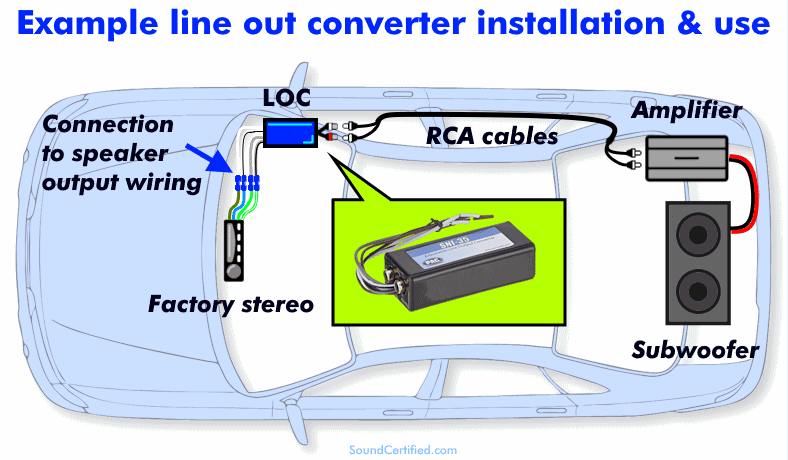
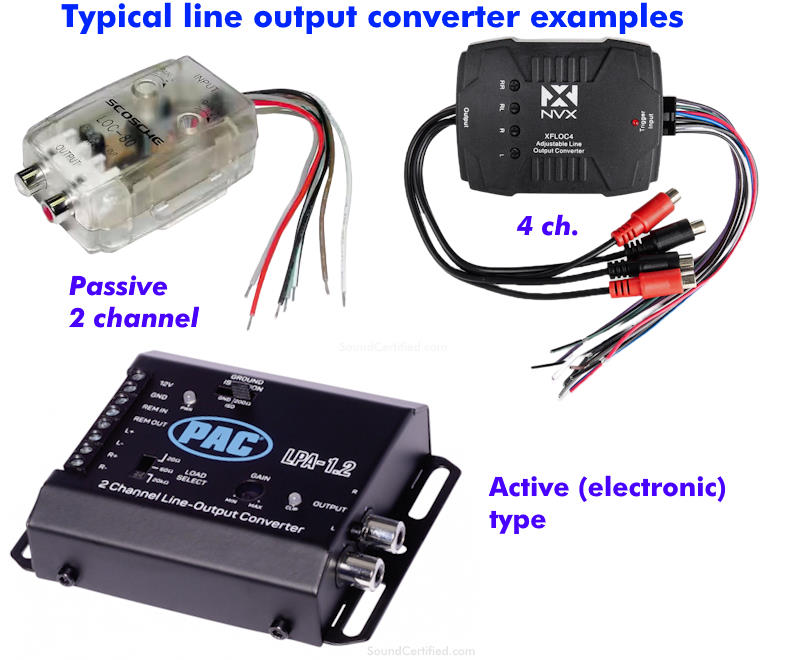

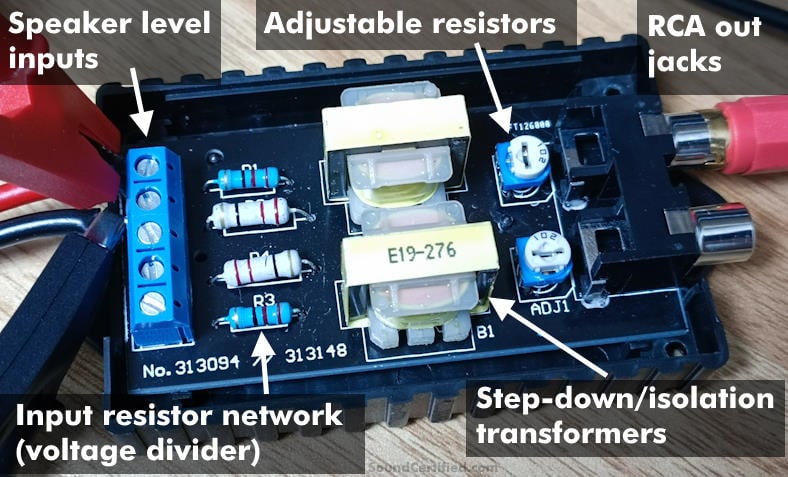
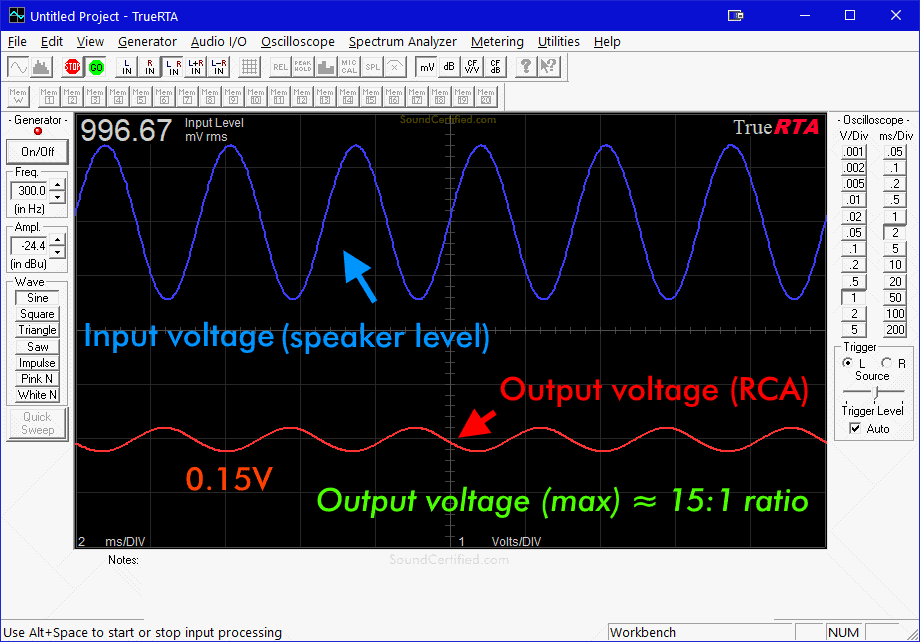
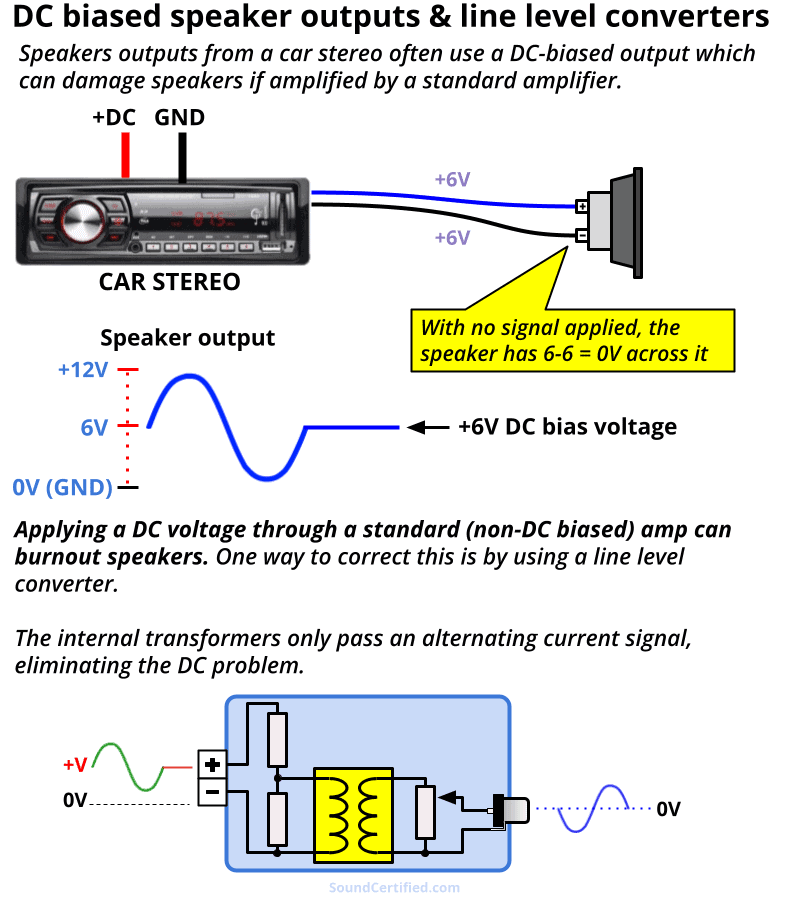
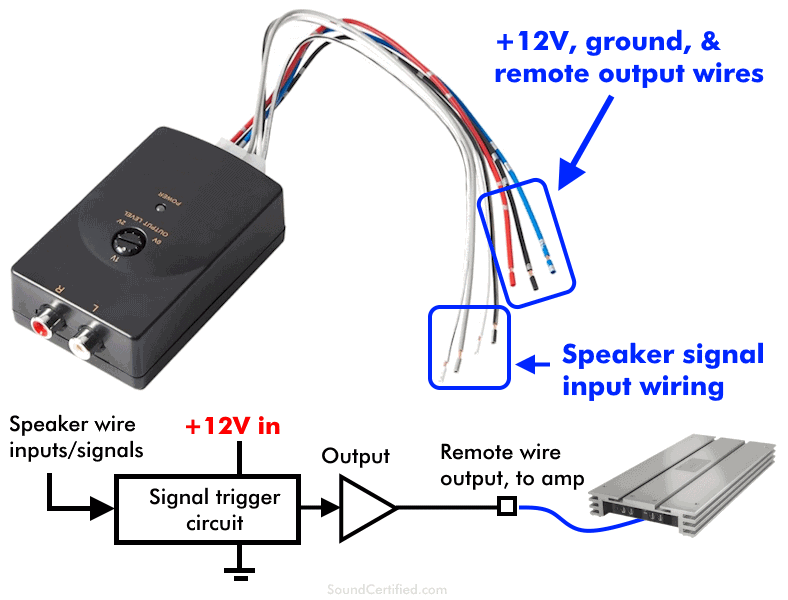
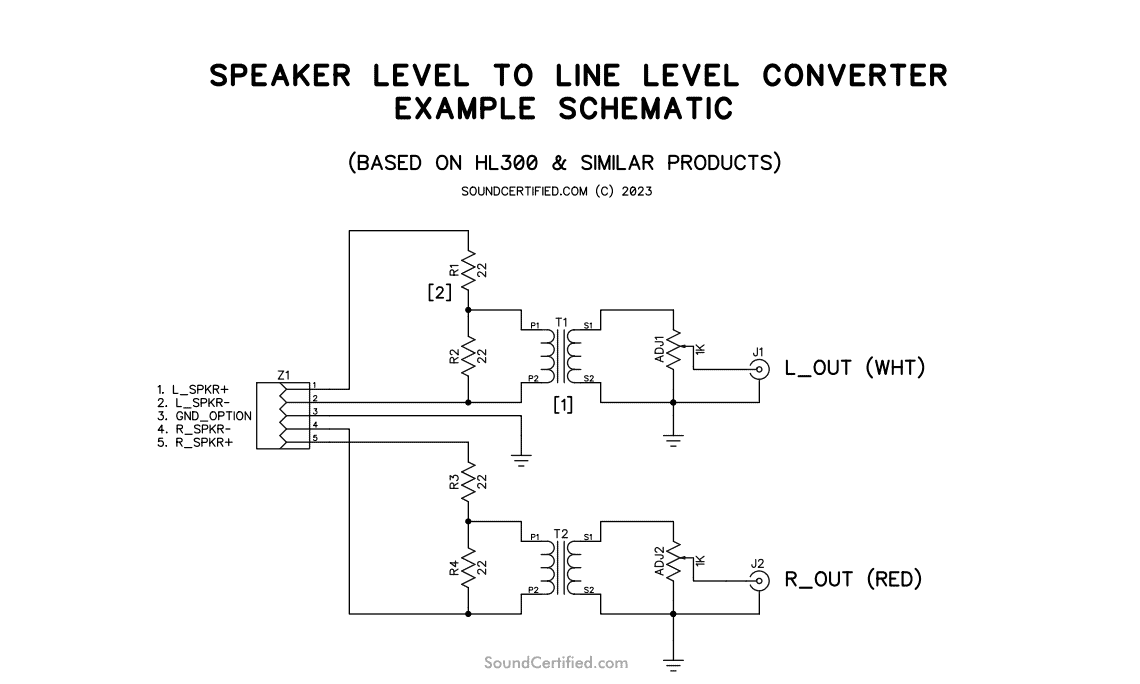
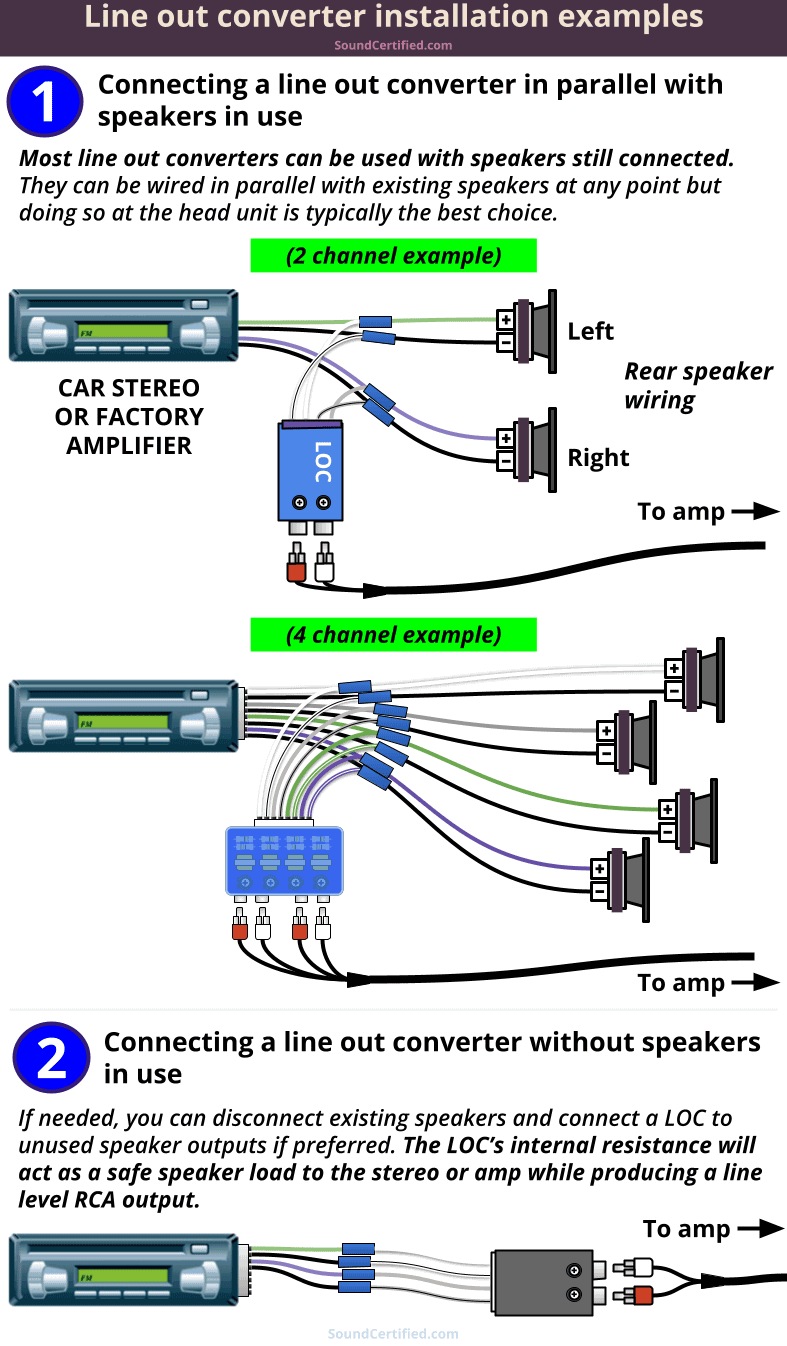


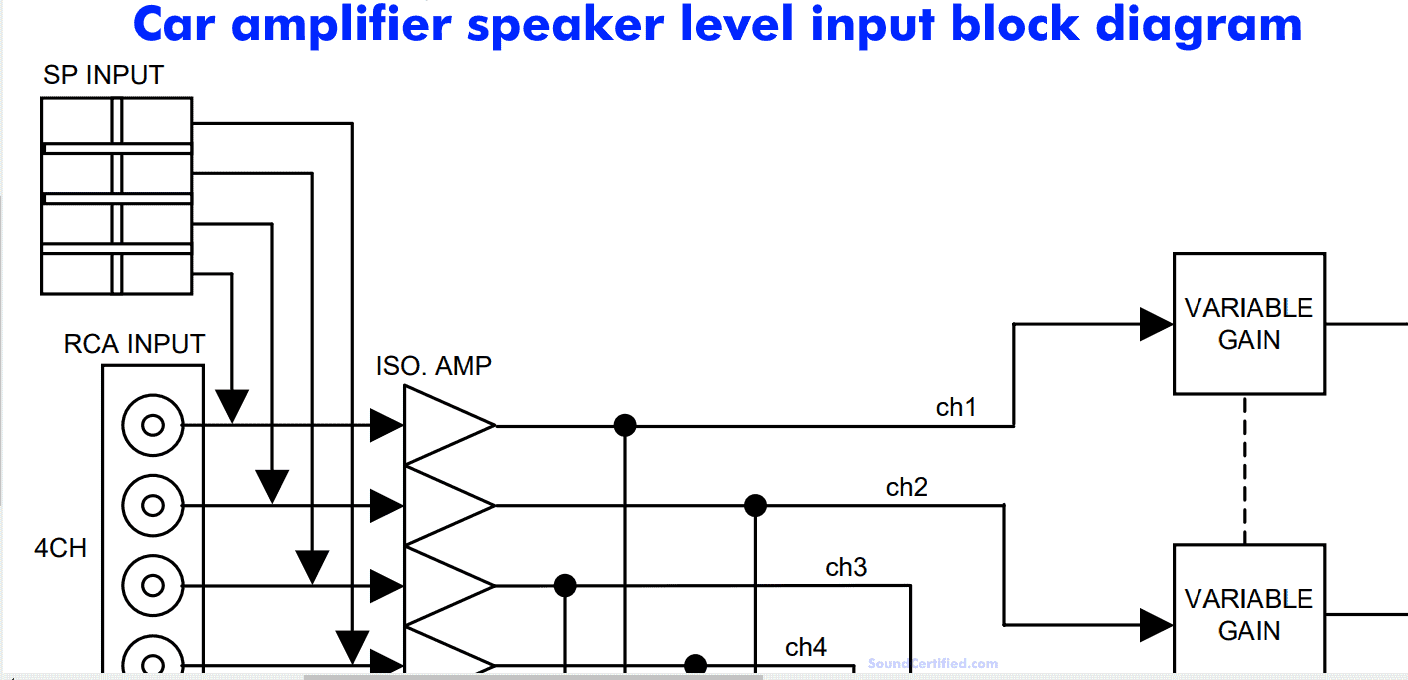
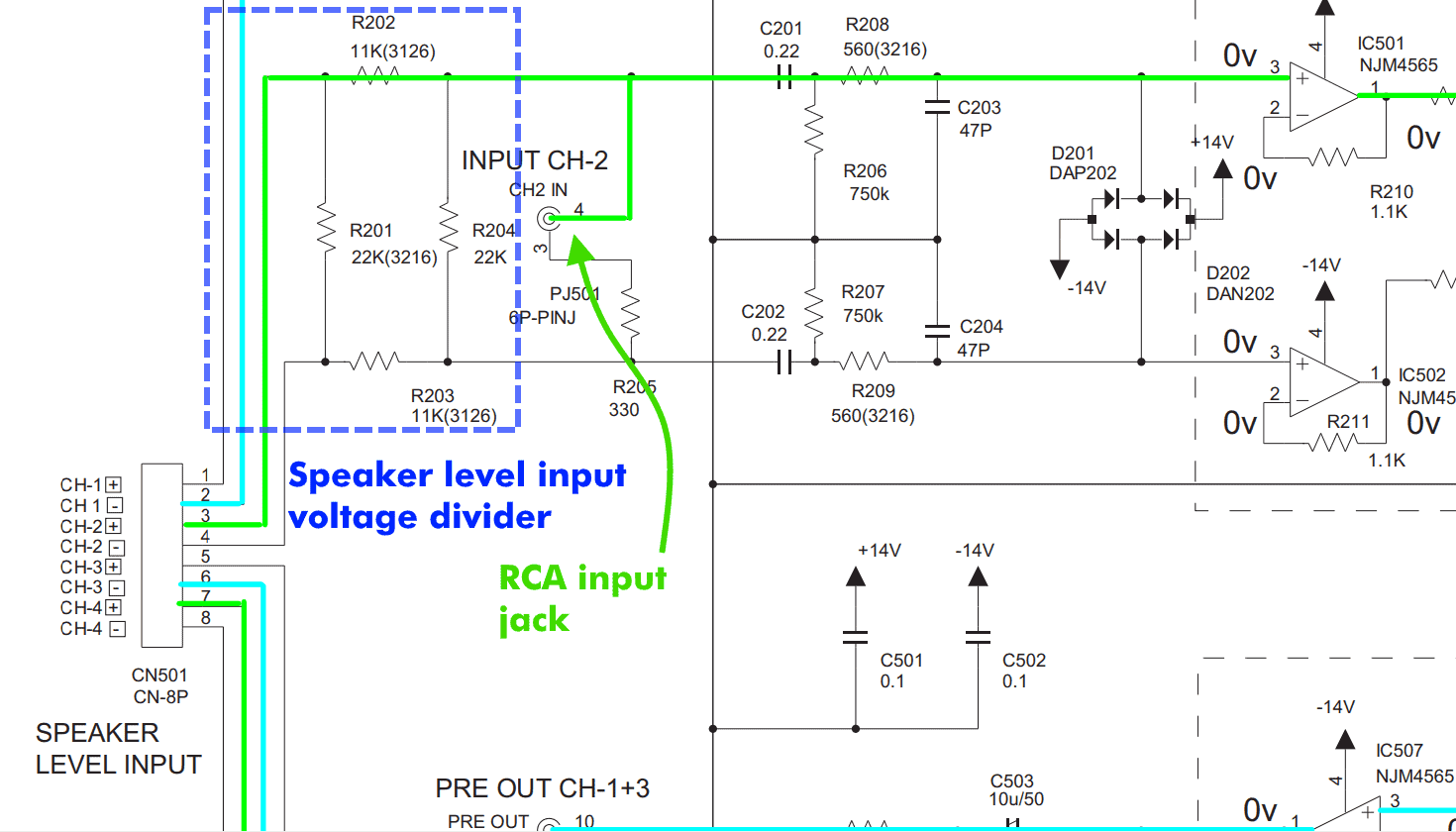

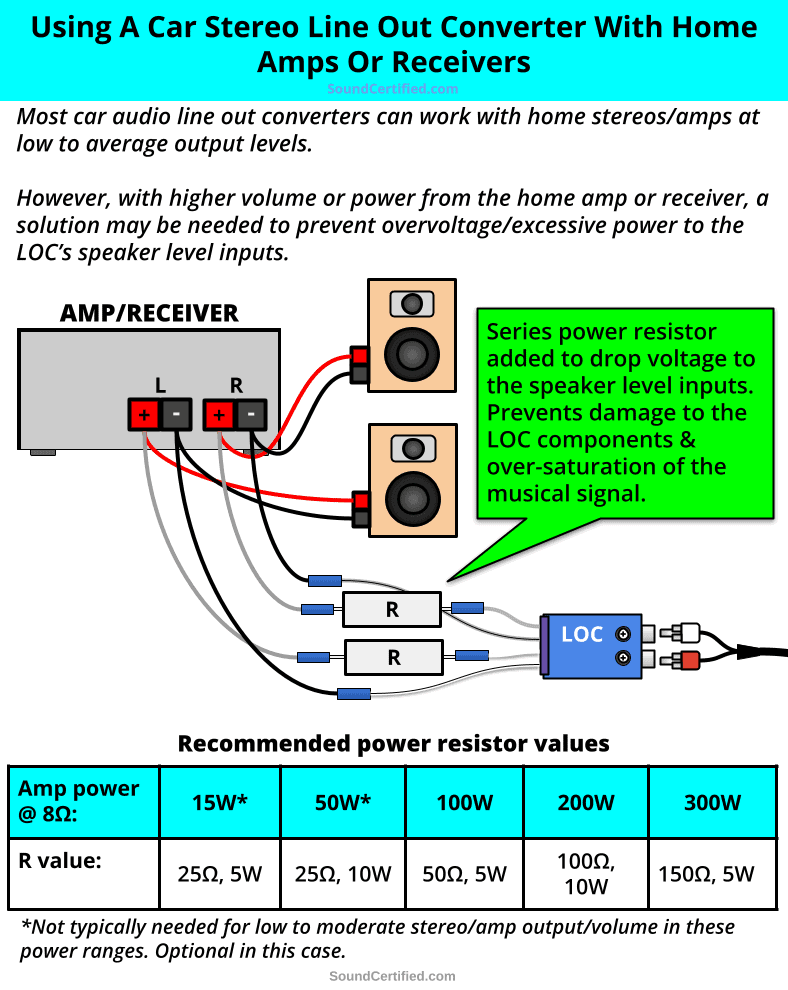
Hi Marty,
I recently bought a small 100w sub/amp combo just to add a little bass to factory stereo of my 2024 Hyundai Elantra. I’m trying to install myself, but am unsure where exactly to tap the loc into my factory speakers. Is it necessary to remove the car stereo?
Hello Dylan. It isn’t really necessary to remove the car stereo, although it can be more convenient in some cases.
You can tap off of the factory speaker wires whereever you can get access to the wiring. In some cases you might need to run a bit of wire to the LOC from speakers. If you’re able to find the factory wiring diagram you can also find the wiring to the rear speakers under the carpet as it’s usually in a harness going to the rear on one side of the vehicle.
I hope that helps some!
Hi Marty –
For an LOC used to add an amp and subwoofer to car audio: what is the effect of bass/treble settings on the head unit to the Line Out signal that gets sent to the amp?
In my situation the current set up is janky: I split the line out from my phone so that one output goes to the car stereo amp and the other goes to the subwoofer so I can control the car audio and the subwoofer completely separately. I would like to integrate an LOC to clean up the installation but want to maintain separate audio controls where the installed speakers don’t use a lot of bass.
Hi Will. For most line output converters (when I say “most”, I mean typical ones, with good sound quality) there should be no effect on bass or treble. However, I have seen cases where cheap ones have a poor frequency response and bass can be reduced and possible treble as well.
**(Note: If you’re using a headphone output and not a real line level output jack, then it is possible that you will have sound quality problems due to impedance problems (headphone vs line output incompatiblities).
It would be better use use a real head unit so that you can control bass and treble separately, but if you can’t, you might also consider using a Bluetooth receiver as they have a real line out jack (unlike the headphone output of a smartphone). Decent ones have pretty nice sound quality.
If you would like to adjust the bass signal and the other separately, you could try using an inline (RCA) volume control as they provide a knob. You could adjust the signal level to the subwoofer amplifier that way.